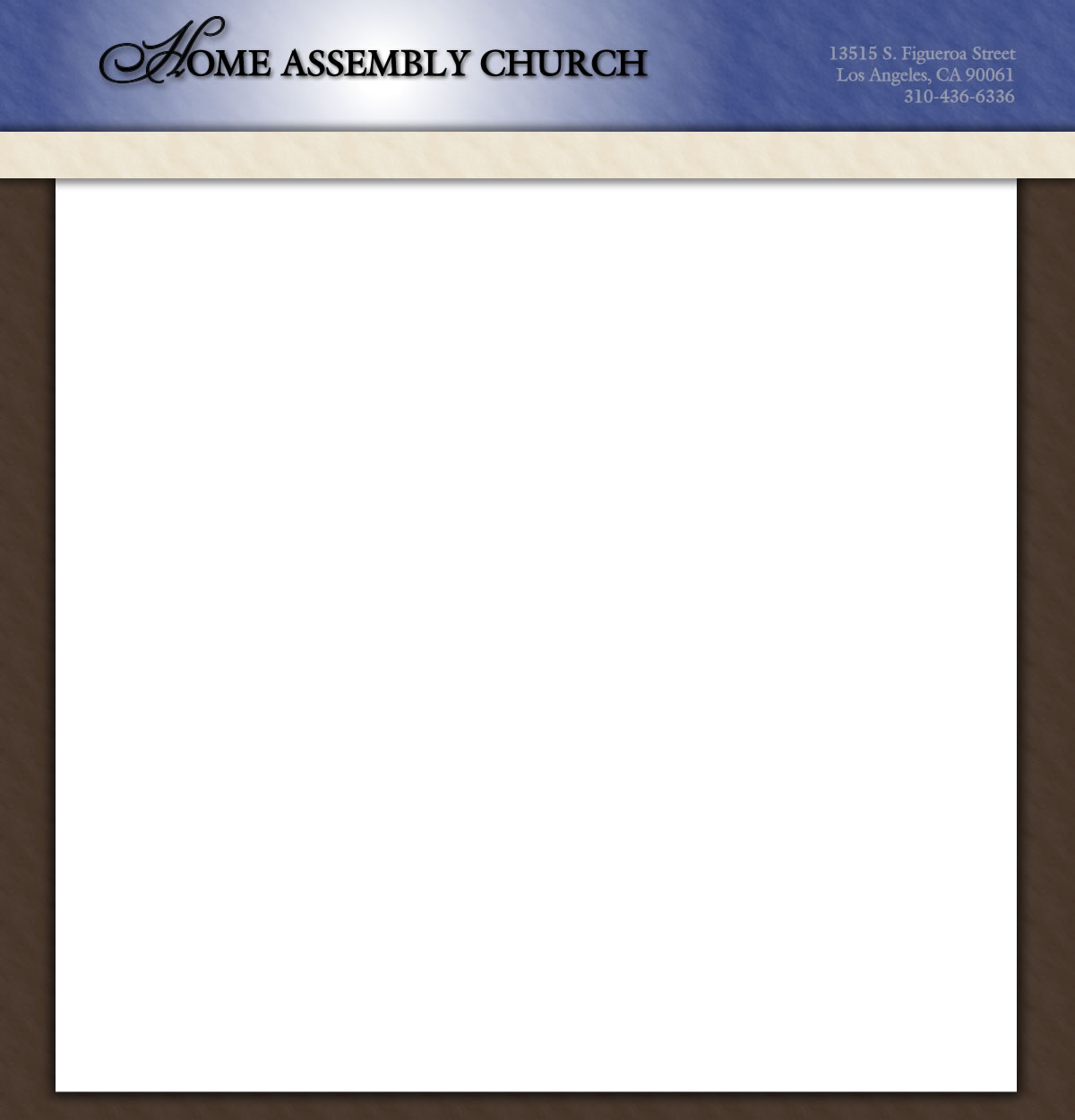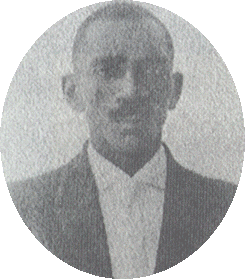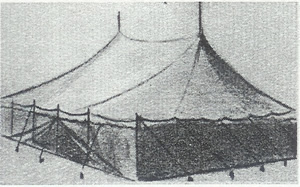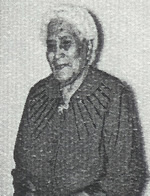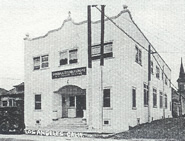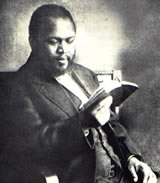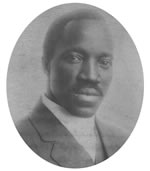CHURCH HISTORY
AZUSA STREET REVIVAL
Born out of the great 1906 Azusa Street revival in Los Angeles, California, the history of The Apostolic Faith Home Assembly, Inc. cannot be properly told without also including a brief history of the Azusa Street revival led by the African-American preacher William Joseph Seymour.
HOME ASSEMBLY IS ESTABLISHED
Through the inspiration of God, the Apostolic Faith Home Assembly, as it is known today, had its origin in the heart and mind of Elder William A. Carson. A native of Chicago, who had previously founded and established several churches in the Midwest, Eld. Carson arrived in
Los Angeles with only seventy-five cents in his pocket in April 1922. He began to hold nightly prayer meetings. The Apostolic doctrine, the mystery of the Godhead and baptism in water in the name of Jesus Christ was preached and taught by Eld. Carson with inspiration and power. Although stooped and crippled from birth, he was a direct, dynamic speaker who stood erect and tall as he preached under the anointing of the Holy Ghost. Many responded and embraced the gospel message with joy. Because of a marked difference in doctrinal precepts, and the eagerness with which hearers were embracing this "Apostolic" message, his first revival meeting was terminated by the host pastor a week before it was scheduled to close.
Elder William A. Carson
1922
Determined to carry out that which God had inspired him to do, Eld. Carson rebounded from this experience and accepted an invitation from Eld. Clemmons to conduct a meeting at 14th Street and Hooper Avenue. It was such a great meeting that the people started coming from other churches (all denominations) all over the city. The congregation grew, and it soon became apparent that larger quarters were needed. Mother Frances Dorman (who received the Holy Ghost before Eld. Carson's arrival in Los Angeles) informed him of an available tent owned by an Eld. Coaling. Eld. Carson appointed a group to meet with the owner to work out a possible purchase of the tent for their use. They were successful and on May 5, 1922, just one month after his arrival in Los Angeles, Eld. Carson began a dynamic tent meeting at 18th Street and Hooper Avenue.
During the Summer of 1922, the congregation hosted a convention where Bishop Haywood was the main speaker. The tent was crowded beyond capacity. Visualizing the need for larger quarters, Eld. Carson began to work towards a permanent church building for the saints.
He drew up an organized plan, appointed a Board of Deacons and a Board of Trustees. Those first church officers were Eld. James B. Carter, Secretary of the Trustee Board with Bro. Johnny Stewart, Sis. Violet Williams, Bro. W.A. Jackson and Bro. Klug appointed as Trustees. Bro. Judge Williams was appointed Chairman of the Deacon Board and Church General Secretary, with Bro. George Allen and Bro. Bacon appointed as Deacons. Sis. Mable Chatman was the first pianist and Sunday School Secretary. Evang. Mary Williams was Secretary of the Building Fund.
In the Spring of 1923, Mother Lucy Bell offered Eld. Carson
the use of the lot she owned on East 33rd Street. (The fountain
on the front lawn of the Adams bore a plaque in her memory.
That plaque has been taken to the Figueroa property.)
Additionally, she and her daughter, Sis. Rebecca Simms,
contributed their entire savings of $1,400 to begin a building
project. Eld. Carson at once initiated a campaign to secure
additional funds for a church building. Initially stymied, he
borrowed from businessmen, banks and those with whom God
gave him favor. As he made both plea and demand, he
continued to pray and preach, confident that God would fulfill
that which he had started. A contractor by the name of
Mr. Frosset was hired, and on April 23, 1923, the foundation was
laid for a church and Saint's Home at 1122 East 33rd Street. That's how the Apostolic Faith Home Assembly got to East 33rd Street. We existed on a fragmented basis out of the Azusa Revival where the oneness came into evolvement, but we just needed to become formulated and established as an organized body!
Four months later, in August 1923, the church was completed. It included a fully equipped auditorium, with seating capacity for two hundred fifty (250) people and upstairs quarters of a living room, a dining room, two kitchens, a bath, four bedrooms, a large porch designed and constructed for utilization as a parsonage and Saints Home.
On August, 11, 1923, The Apostolic Faith Home Assembly, Inc. was officially incorporated in the State of California.
On August 17, 1923 the new "Apostolic (Faith) Assembly & Home" was occupied by
Eld. Carson and the saints of the church, with Eld. Floyd Ignatious Douglas, of Louisville, Kentucky, preaching the dedication services.
He learned about the tongues-attested baptism in a Bible School that Charles Fox Parham conducted in Houston, Texas in 1905. Invited to pastor a Black holiness church in Los Angeles in 1906, Seymour opened the historic meeting in April, 1906 in a former African Methodist Episcopal (AME) church building at 312 Azusa Street in downtown Los Angeles.
For over three years, the Azusa Street "Apostolic Faith Mission" conducted three services a day, seven days a week, where thousands of seekers received the tongues baptism. Word of the revival was spread abroad through The Apostolic Faith, a paper that Seymour sent free of charge to some 50,000 subscribers. Eventually, though, schisms developed and the glorious Spirit and presence of the glory of the Lord began to wane, and the Azusa Street Mission was forced to close.
While Seymour was a devout and humble holiness minister, and while the 1906 outpouring of the Holy Ghost is recognized as the impetus of the modern "Pentecostal movement", one must remember that it was just that -- a Pentecostal experience. While many received the Holy Ghost through this revival, many remained confused as to the true doctrine of Jesus Christ.
One who did not remain confused
was Bishop G. T. Haywood. He comprehended and accepted
the oneness doctrine. Through
the Holy Ghost, he comprehended
that Jesus and God are one and the same, that it was Jesus whose blood was shed for the remissions of sins; therefore it is through Jesus you get repentance. He understood that the right way to be baptized as the way that Peter preached it on the day of Pentecost - that you have to be
baptized in the name of Jesus if you intend to identify with the death, burial and resurrection of the Lord Jesus Christ; and you cannot do it any other way.
As Bishop Haywood became very aggressive in making it known that he believed in the oneness of God and in the Jesus name issue, the Pentecostals rejected him, even his own! He decided it was necessary for us to have an organization that believed in the Jesus name issue. When Bishop Haywood realized it, he then began the Pentecostal Assemblies of the World in 1906 in the city of Los Angeles. He began preaching, and teaching and holding a lot of meetings constantly promoting this truth. Over the years, through meeting after meeting, revivalist after revivalist, the number of believers in the Oneness Doctrine grew. There was no pastor, but the membership grew -- Bishop Haywood and different other ministers at that time who were promoting this truth took the time to stay in Los Angeles and build this doctrine up. It was received into people's hearts and allowed the doctrine to spread.
